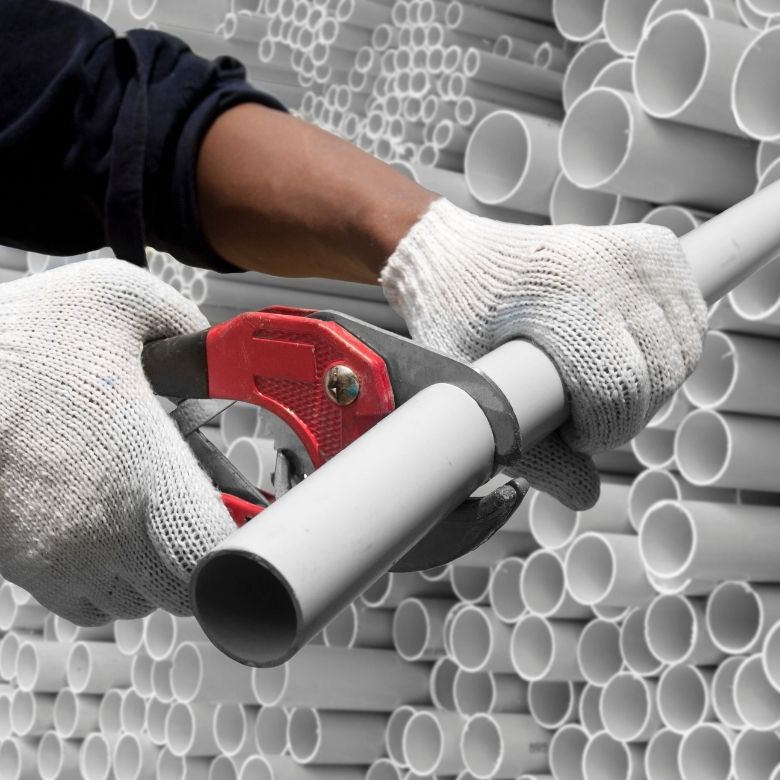For nearly one hundred years, plastic made of polyvinyl chloride, abbreviated as PVC, has been used in almost all branches of trade and industry, as well as in our homes. It is a low-cost, highly durable and widely available raw material that is produced in many different variants. In our article, we will discuss what is the material commonly referred to as PVC, what properties it has and what can be made from it.

Polyvinyl chloride: how it is obtained
PVC is made in specialised mixing plants, as a result of the polymerisation of vinyl chloride. This process consists in the gradual transformation of homogeneous monomers, which are simple and lightweight particles, into larger particles, known as polymers. The production of polyvinyl chloride involves liquid dichloroethane (ethylene chloride, dichloroethane), aqueous solution of potassium hydroxide, plasticisers, stabilisers, fillers and pigments.
Polyvinyl chloride can be obtained by one of the three known processing methods:
- bead polymerisation, suspension polymerisation (this process uses suspension fixatives – the shape and structure of the final product resembles that of beads),
- emulsion polymerisation (it is a rapid reaction that involves surfactants, initiators and stabilisers),
- mass polymerisation (this is a very commonly used method of obtaining polyvinyl chloride due to the small amount of raw material impurities).
Polyvinyl chloride: properties and benefits
What properties of polyvinyl chloride have made it one of the most commonly chosen plastics (next to polystyrene, polypropylene and polyurethanes)? As a raw material:
- it is easy to thermally and mechanically process (glueing, abrasion, milling, bending; both hard and soft, flexible PVC types are available on the market – therefore, the properties of each PVC type can be tailored to individual needs),
- it can tolerate high loads and pressure,
- it does not produce an objectionable odour,
- it is non-toxic,
- it works well at both high and low (negative) temperatures,
- it is not susceptible to the destructive effects of moisture, acids and bases.
What else should we know about PVC? The properties of this material are impressive: it has a low heat transfer coefficient, it is not flammable and it perfectly isolates electric current, light and sound. Polyvinyl chloride does not absorb grease or chemicals and it does not create a favourable environment for the accumulation of pathogenic microorganisms.

Vinyl chloride: home and business uses
What can PVC be used for? This raw material has versatile uses in industry and everyday life. Polychloride vinyl is nearly everywhere you look:
- it is a component of hydraulic, electrical and ventilation systems in buildings (PVC pipes, conduits, hoses and sheaths, equipment and housing elements, gutters),
- it is used for the construction of partition walls (foamed PVC sheets), insulation of buildings,
- it is a component of packaging, clothing elements (including specialist footwear, helmets and protective vests),
- it can be used to produce toys, kitchen wall coverings, table mats,
- it is a valued construction material in the window and door joinery industry, necessary for the production of energy-saving window profiles and window sills,
- in medicine, it is used in the manufacture of prosthetic limbs, hearing aids, protective films, syringes or tubes (as such, it is known as medical-grade PVC),
- decorative PVC films are used to protect furniture fronts,
- PVC strip curtains provide thermal insulation in various types of warehouses, processing plants and cold storage facilities,
- in the advertising and printing industry, printing on PVC boards, as well as commercial plafonds, signboards and advertising signs made of PVC are popular.
As the world and the needs of civilisation are changing, new creative ideas for the application of PVC are continually emerging. It is undoubtedly one of the most promising, continually improved raw materials of the future.
- Polymer Handbook, ed: J. Brandrup, E.H. Immergut, E.A. Grulke, Wiley VCH, 2003
- https://pvc.org/about-pvc/
- https://www.ebi.ac.uk/chebi/searchId.do?chebiId=53243